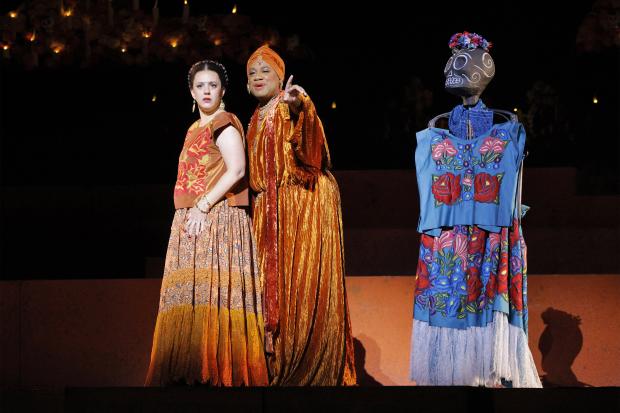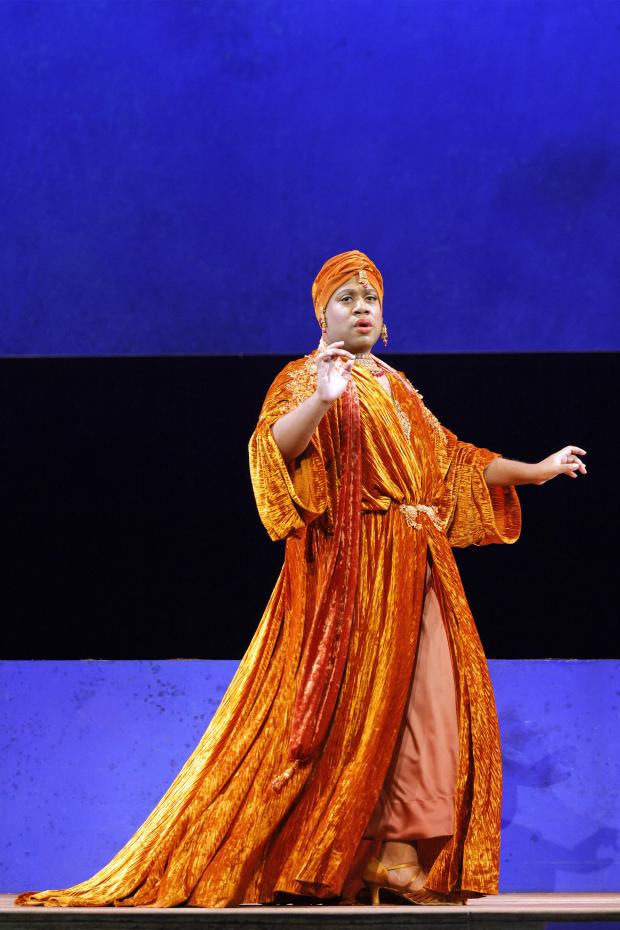If ever there was an operatic couple absolutely ideal for immortalization in the musical medium of maestros Mozart, Puccini, Rossini, Wagner, and company, it’s Frida Kahlo and Diego Rivera. They are indelibly iconic as Mexico’s premiere artists, communists and legendary lovers. Their romance and marriages were marked by intense ardor and infidelity, with equally passionate politics, befriending the beleaguered co-leader of the Russian Revolution after Leon Trotsky was exiled from the Soviet Union and sought refuge in Mexico. Of course, Rivera’s masterful murals and Kahlo’s expressive canvases are the aesthetic foundations of their lasting renown.
Latin Grammy winner composer Gabriela Lena Frank and Pulitzer Prize winner librettist Nilo Cruz have teamed up to pay homage to the (on-again, off-again) husband and wife painters with the 2022 opera El último sueño de Frida y Diego (The Last Dream of Frida and Diego). LA Opera’s production has a heavy infusion of Hispanic talent; the composer is of mixed heritage that includes Peruvian lineage, while the librettist was born in Cuba. Frank and Cruz’s almost two-and-a-half-hour, two act opera eschews the leftwing couple’s famed politics and focuses instead on the lasting loving bond of what some consider to be one of the great romantic couplings of the ages, and the influence of Mexican culture on Frida and Diego.
In LA Opera’s company premiere of El último sueño de Frida y Diego (which debuted in 2022 at San Diego Opera), the curtains quite cleverly seem to be inside of a golden picture frame. When the curtains lift a tableau of a cemetery, presumably near Mexico City, appears on the stage of the Dorothy Chandler, brilliantly rendered by Mexican scenic designer Jorge Ballina, enhanced with spectral lighting by Mexican lighting designer Victor Zapatero. It is the Dia de los Muertos (Day of the Dead), November 2, 1957, and the music and tonality of the ochre-hued sets and costumes (by Mexican costume designer Eloise Kazan) are appropriately somber. The sound emanating from the orchestra pit, presided over by Colombian Lisa Gonzalez-Granados, L.A. Opera’s resident conductor, is here heavy on percussion and unless my untutored ears deceived me, with chimes, too.
A forlorn Diego Rivera (Mexican Baritone Alfredo Daza) enters and implores his dearly departed wife to come back to the aging, ailing, alone muralist. La Catrina, Keep of the Dead (Puerto Rican soprano Ana Maria Martinez), who poses as a flower seller to Diego in the graveyard, travels to the Aztec underworld, Mictlan, to summon the three years dead Frida (Argentine mezzo-soprano Daniela Mack) back to the land of the living. In a visually stunning mise-en-scène, parts of the set arise and seem to floating, enhancing the unearthly sensibility of the realms of the dead being depicted. Once Catrina sheds her earthly apparel and assumes her otherworldly identity, her outrageously eye-popping ghostly costume deserves to be remembered at awards time.
For her part, the much-afflicted Kahlo, who’d suffered so much while alive, is conflicted by the notion of returning to life, bemoaning the “two accidents” she’d suffered during her lifetime: Being hit by a trolley while a teenager (which permanently impacted the health of this woman who died long before her time when she was only 47) and Diego Rivera. Their’s was an impassioned relationship but also an extremely mercurial, turbulent, turbocharged one – they may have loved each other deeply, even madly, but they were famously unfaithful to one another. (Diego dallied with, among others, Frida’s sister, and the reputedly bisexual Kahlo – as depicted in Salma Hayek’s superb 2002 film Frida – enjoyed peccadilloes with Trotsky, as well as other women).
Reluctant to come back to life and possibly re-experience the crippling pain she’d endured while amongst we mere mortals, what presumably wins her over to a brief sojourn back to the land of the living is that her nonetheless beloved Diego is suffering – he misses and needs her. Plus, she yearns for art! Act II opens with another visually arresting tableau – Rivera’s Georges Seurat-inspired mural Dream of a Sunday Afternoon in Alameda Park, stretches across the stage with live performers striking the poses in the painting that a listless Diego, clad in paint-splattered overalls and perched atop scaffolding, is attempting to paint. He is listless until Frida appears, and they enter the mural together.
Diego takes Frida to Casa Azul (the Blue House), her home and studio. In a series of frames suspended from the ceiling performers strike poses derived from Frida’s oils, which often expressed her pain and suffering. At one point the wife wryly tells her philandering husband: “All the hurt I painted instead of killing you.” The lovers affectionately call each other by their nicknames: “Palomita” or Little Dove is what Diego dubs Frida, who refers to her older, overweight partner as “little toad.” (The cremated Kahlo’s ashes are, amusingly, inside of a pre-Colombian urn shaped like a toad at Casa Azul – not, BTW, in a cemetery.)
There is a touching yet droll scene when Frida, who’d had one limb amputated, once brought back to life, lifts her skirt to make sure she has two legs and feet and, when finding she does, performs a lively dance. Rivera may have painted frescoes frozen in time, but Mexican choreographer Ruby Tagle Willingham’s dances are full of movement.
Various scenes during the opera present a panoply and pageant of the Mexican history that imbued these artists and their work: Indigenous Aztecs, conquistadors, missionaries, campesinos, Spaniards, etc. There are serapes and sombreros galore amidst the colorful cast, making for some very vibrant mise-en-scène to delight the orbs (as is only natural for a production about painters), adeptly helmed by Mexican director Lorena Maza in her LA Opera debut.
I’d be remiss not to mention the character Leonardo (Kentucky countertenor Key’mon W. Murrah), who cross-dresses as Greta Garbo, and like Frida briefly leaves the land of the dead for the realm of the living, garbed as Garbo. Along with chorus director Jeremy Frank of Montana, Murrah is one of the few major cast and crew members of El último sueño de Frida y Diego who is not Latino. It is also noteworthy that the lyrics are sung in the Spanish language, whereas operas performed in Italian, French and German are more common in the canon. And for the first time that this longtime opera reviewer can recall, the program is both in English and Spanish (at least in part).
According to San Francisco Opera’s website, composer Gabriela Lena Frank’s work includes: “Chronicles of the Picaflor (Hummingbird) (Philadelphia Orchestra); Apu: Tone Poem for Orchestra (Carnegie Hall); Conquest Requiem (Nashville Symphony for the Naxos label; Metropolitan Opera). She regularly receives commissions by musicians such as cellist Yo-Yo Ma, soprano Dawn Upshaw and conductors Marin Alsop and Yannick Nézet-Séguin. She has also received orchestral commissions and performances from the Chicago Symphony, Boston Symphony, Atlanta Symphony, Cleveland Orchestra, Philadelphia Orchestra and San Francisco Symphony. Composer in Residence (Philadelphia Orchestra). Visiting Artist-in-Residence at the Blair School of Music with Vanderbilt University. Winner of Latin Grammy. Holds Guggenheim Fellowship and USA Artist Fellowship.”
The work by Cuban-American librettist Nilo Cruz, who migrated from Castro’s Cuba to Miami’s “Little Havana” in 1970, includes: “Jimmy López’s Dreamers oratorio (Cal Performances Berkeley); Exquisite Agony (New York, Miami, Washington D.C.); A Park in Our House (Boca Raton); Two Sisters and a Piano (New York, Miami, Seattle); Anna in the Tropics (Tacoma, Pasadena, Tampa, Pittsfield); Hortensia and the Museum of Dreams (Chicago); Lorca in a Green Dress (Northridge, San Diego); Hotel Desiderium (Miami). Winner of 2003 Pulitzer Prize for drama and Tony Award nomination (Anna in the Tropics).”
El último sueño de Frida y Diego is a moving, musical meditation on death focusing on the love and artistry of the immortal title characters. Anyone interested in Kahlo and Rivera should, by all and any means, see it. Some members of the audience were adorned in vivid fashions, evoking Frida’s couture. But Diego and Frida minus their revolutionary idealism, which animated them in their artistry and activism, is well, similar to Frida after her amputation. It’s like Aunt Jemima’s pancakes without the syrup. I actually think that “the last dream” of these committed communists was worldwide, socialist revolution. So, shorn of their politics, by ignoring this essential aspect of their beings, something vital is missing from an otherwise visually compelling, operatic rendition of their endless love story.
El último sueño de Frida y Diego is being performed Thursday, Nov. 30, Wednesday, Dec. 6 and Saturday, Dec. 9 at 7:30 p.m., plus on Sunday, Dec. 3 at 2:00 p.m. at the Dorothy Chandler Pavilion, 135 N. Grand Avenue, Los Angeles CA, 90012. For tickets: https://www.laopera.org/performances/202324-season/el-ultimo-sueno-de-frida-y-diego/; (213)972-8001. El último sueño de Frida y Diego is sung in Spanish, with English supertitles.



